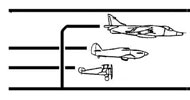| Name: | |
| John Richardson | |
| Transcript: 6 | |
| Hunter drop tanks, air freighting and the Torrey Canyon | |
Building crates for drop tanks was a major area of work for the Casemaking Department. John talks about the use of drop tanks on the Hawker Hunter and how they were used during the Torrey Canyon disaster of 1967, when Hunters from RAF Chivenor were used to drop aviation fuel onto oil emanating from the stricken tanker in order to set it ablaze.Harriers were sent from the Kingston factory to McDonnell Douglas in America and John relates how one was delivered in error to a bemused Texan farmer.So you were in charge of casing. So what kind of things – how would you go about casing various components? Well, a lot of those people in that photograph are case makers, carpenters. And we’d make huge wooden boxes. Those pictures, that picture there – those boxes are about eighteen feet long and about three and a half feet square. So in there is a drop tank. Could you explain what the drop tanks were and what they were used for? Right, it carried two hundred and thirty gallons of fuel and those ones there were off the Hawker Hunter. You put one under each wing which gave the aircraft much greater range. It’s like a car – so you’ve got ten gallons you do ten miles to the gallon, a hundred miles. If you stick a couple of these on and it doubles your range and what you could do – you didn’t do it in peace time, of course – but what you could do, once they were empty you could drop them. What they’d try and do, is if they had a base nearby, they’d drop them in the sea and they’d send a tender out to pick them up. Given that you were part of a team that was making them did you ever see them be tested? No. I tell you what did happen when they – this will be for your older listeners – when they had the Torrey Canyon, they were dropping these on the Torrey Canyon full of fuel and they dropped napalm on top to burn it all off. The television studios at Teddington and they wanted pictures of one – could they borrow one. Yes – and they turned up in a dormobile. Them things are eighteen feet long and about two foot diameter [the drop tanks] so you couldn’t get it in there or tie it on the top. So what we did we picked one up on the crane and we had a person standing at each end and they photographed it. So they could get an idea of how big they were. OK, so after casing where would you transport them to? We wouldn’t, they would be taken away to where ever. Sometimes the R.A.F would come and collect them themselves. If it was export, it would either go to the docks or off to London Airport. The Harrier – the American Harriers – all went to London Airport. They used to come every Friday lunchtime and pick them up because they had a special plane, would come in every Friday afternoon to take them to America. Ah, I’ll tell you a funny story about that. McDonnell Douglas had a place – I can’t think of it at the moment. Anyway these crates are big – you can imagine an aeroplane, no wings just the fuselages in them. And they used to go to this – oh, (not ????) anyway it doesn’t matter, they’d go to this place, it’s in the middle of America somewhere. And one day there’s a farmer in Texas standing by his gate and a lorry turns up – ‘this is for you’. ‘What is it’? And it was Pan Am then. Somehow they had got it all mixed up and took it to this farm in Texas. A whole Harrier! But it got bad – in the end McDonnell Douglas wouldn’t deal with them. They dealt with – I think it’s called Air Britannia – it’s an English company. They all, their stewardesses all wear tartan. I think it’s called Air Britannia or something like that. And they did all their air freighting.
|
|


